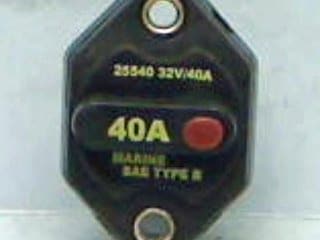
sae type b_3610.jpg

SAE Type B Thermal Circuit Breaker
Today’s post came in as a question from one of our readers. Its a really good question, so let me share:
Ed-
I have a 30 amp Cooper Bussmam Series 25X Mid-Range circuit Breaker #25530 SAE Type B that I need to replace. The only thing I have found online or in a store similar is the 40 amp #25540. I don’t know if this was an OEM part or not. It fits in a custom housing or I would use a different brand. The 40 amp is the same shape. Can I use a 40 amp in place of the 30 amp?
Rob
This is a fairly common question and its a good one because it does not have a simple yes or no answer. It may be OK to use the 40 amp breaker as long as the wire its installed in has sufficient “ampacity”.
The other issue with this case is the AIC (ampere interuppting capacity) rating of the breaker. Also in some cases, depending upon whether the boat uses gasoline for fuel and where the breaker is located, whatever breaker gets used must be rated for ignition protection.
So, let’s look at the issues one at a time. First of all, the Bussman breaker Rob is referring to is rated for ignition protection, so that means it can be used anywhere on the boat without fear of it causing an explosion, always a good thing.
Since these particular breakers are usually used as main breakers in DC systems, there might be a problem with the AIC rating, which for this device is only 2500 amps. ABYC requires breakers to meet certain AIC ratings based on the size of the battery bank, or more precisely the CCA rating (cumulative) of the batteries they are connected to. the problem here is that the minimum requirement is for a 1500 amp AIC rating for a master breaker, and that is for a battery or battery bank that only has a cumulative Cold Cranking Amp rating of 650 or less. That folks is a pretty small battery. Typically a standard group 24 size, and no more. As soon as you add a second battery or move up to say a group 27 size, you are going to be past that 650 Amp CCA rating. That means, according to ABYC, that you are going to need to up your AIC rating for that first main circuit breaker to a minimum rating of 3000 amps AIC. So, Rob, not sure what you have for a battery or batteries, but this install may not be compliant for that reason.
Next, we have the matter of the nominal amp rating for the breaker. 30 amps vs. 40 amps. Ro’bs basic question is, hey Ed, any harm done by just bumping the original 30 amper up to 40 amps?
It depends on the wire in the circuit. ABYC rates the sizing of fuses and circuit breakers based on the amperage handling capabilities of the wire it is installed in. That is determined by a few factors, but the basic considerations are the wire’s insulation temperature rating, and AWG size as well as whether it is routed through an engine room space or outside an engine room space. Fatter wire with a higher temperature rating for the insulation can theoretically handle more amperage, so it “ampacity” is higher.
ABYC says that the overcurrent protection rating for conductors (wire) can be no greater than 150% of the ampacity of the conductor that it serves..
So, Rob to answer your question, with all of this taken into consideration looking over the tables in ABYC tells me that if the wire that breaker is installed in is 10 AWG or bigger, and it is in fact 105C rated cable, there will be no harm done by switching that 30 amp breaker for a 40 amp breaker.
BUT, keep in mind readers, you must take into consideration all of the things mentioned here to be sure. If you are unsure, go through this drill backwards and use the Blue Sea Circuit Wizard hot button calculator in Ed’s Tool Box to figure it all out.







